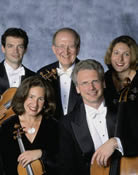This review is an Ionarts exclusive.
 The Kennedy Center Chamber Players never disappoint, and Sunday afternoon in their first appearance this season at the Terrace Theater, they presented an exceedingly fine concert of music by Fauré and Tchaikovsky. The group strikes a balance between collective musical ownership and the guidance of a single leader -- the ever graceful, but strong Nurit Bar-Josef. The opening theme of the first piece, Fauré’s Quartet No. 1 in C minor, is declared right away in unison by the strings -- an immediate pronouncement of the Chamber Players’ tight ensemble playing -- offset by thick chords in the piano on the offbeats. Pianist Lambert Orkis, in his extended solo parts, showed his ability to create strikingly long phrases and not give in to the seasick back and forth style of phrasing (which is certainly appropriate in some instances). He was truly unaffected, and for this style of late 19th-century French music, it was perfect. However, notes were dropped in many of the technically demanding spots that required flitting back and forth and spanning of the whole keyboard (although it certainly did not help that he was turning his own pages).
The Kennedy Center Chamber Players never disappoint, and Sunday afternoon in their first appearance this season at the Terrace Theater, they presented an exceedingly fine concert of music by Fauré and Tchaikovsky. The group strikes a balance between collective musical ownership and the guidance of a single leader -- the ever graceful, but strong Nurit Bar-Josef. The opening theme of the first piece, Fauré’s Quartet No. 1 in C minor, is declared right away in unison by the strings -- an immediate pronouncement of the Chamber Players’ tight ensemble playing -- offset by thick chords in the piano on the offbeats. Pianist Lambert Orkis, in his extended solo parts, showed his ability to create strikingly long phrases and not give in to the seasick back and forth style of phrasing (which is certainly appropriate in some instances). He was truly unaffected, and for this style of late 19th-century French music, it was perfect. However, notes were dropped in many of the technically demanding spots that required flitting back and forth and spanning of the whole keyboard (although it certainly did not help that he was turning his own pages).
The second movement was brilliant: a showcasing of the pianist, whose part is ever quick and nymph-like in its devilish delicacy. Orkis handled the part beautifully, and the accompanying pizzicatos in the strings were in tune and together. The false ending in the scherzo is a delightful quirk that is immediately followed by similar music in the piano, but the strings at this moment are different. Subdued and again in an accompanying role, the strings were unadorned and without vibrato, which created an ethereal sound since the players tuned so well. The opening of the third movement highlighted the group’s dynamic as an ensemble: the movement starts with a single line in the cello, seamlessly joined by the other strings, sounding all the while as one voice that is simply growing in strength.
Without their violist, Daniel Foster, the ensemble went on to something different in the second half of the program, Tchaikovsky’s Trio in A minor. The opening piano starts from nothing and sets the stage for the cello, played by the formidable David Hardy, who then passed his theme without effort to Josef. The first movement, Pezzo elegiaco, a broad sonata form, is almost rhapsodic in the ground it covers and in a seemingly irregular form. At one point, the first violin trailed off hauntingly before a slow middle theme, which was stunning in its mournful temperament. The second movement is a gigantic theme and variations, whose theme is a pastoral, simple melody begun in the piano. Imitated by the violin and cello, the music’s breadth then encompasses everything from that rich Russian fire to more folk-like sounds. The ensemble easily went from one thematic material to the next and, pulling out all the stops, summoned that overly Romantic, Russian tugging-of-heartstrings sound to bring the piece to an exciting close.
The next concert by the Kennedy Center Chamber Players (January 10, 2010, 2 pm) will feature a program of three Brahms sonatas (violin, viola, and cello) with piano.


























































